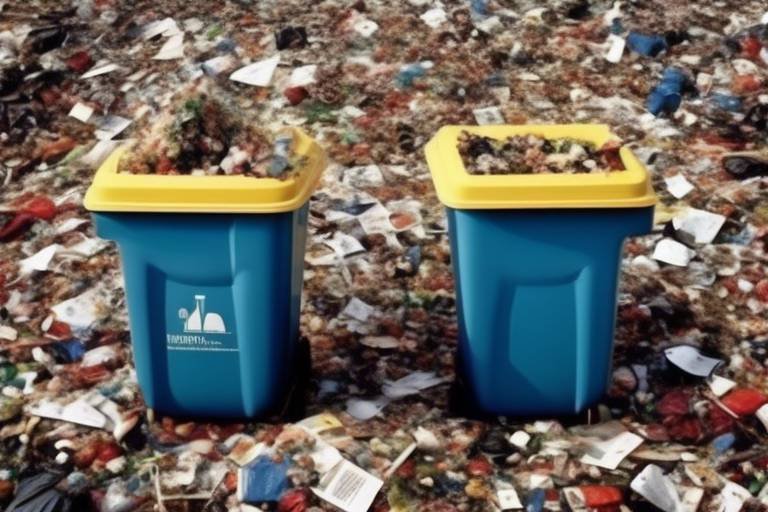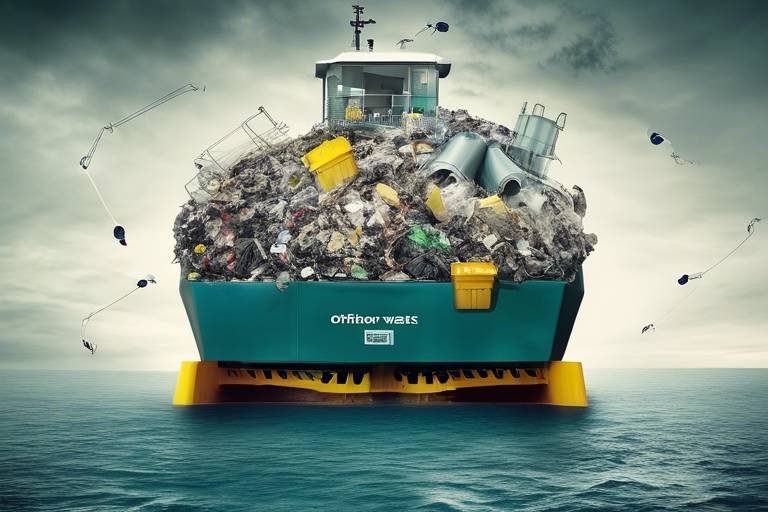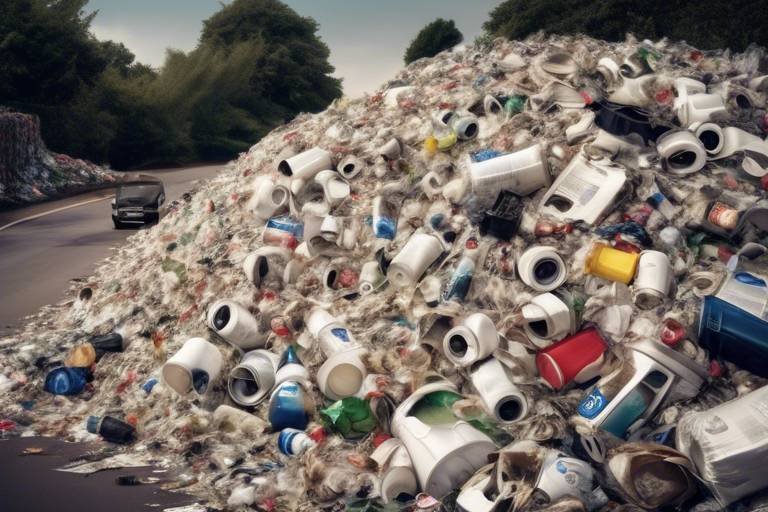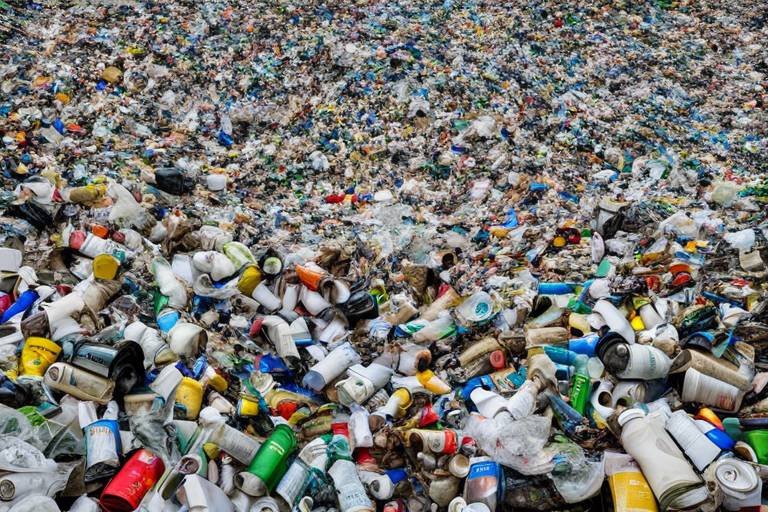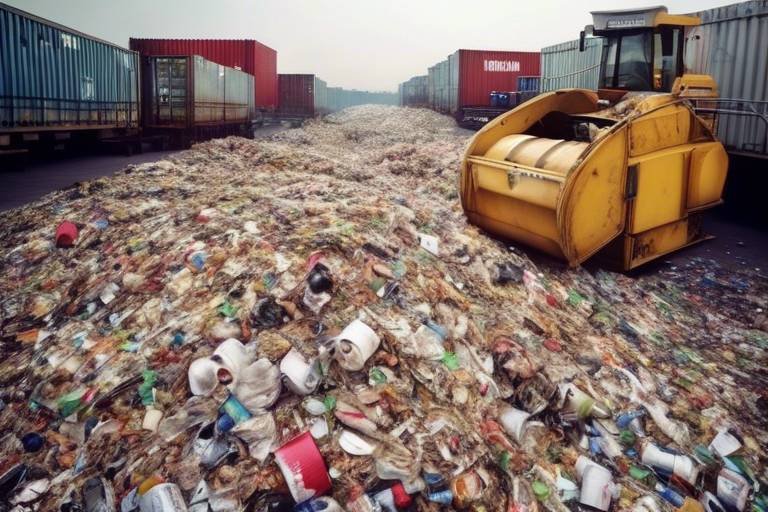How Fast Fashion Contributes to Waste?
Fast fashion is more than just a trend; it’s a phenomenon that has reshaped the way we think about clothing and consumption. In a world where new styles seem to emerge overnight, the rush to keep up comes at a staggering cost to our environment. Think about it: when you buy a shirt for the price of a coffee, what happens to it once it’s out of style? Unfortunately, the answer is often a one-way ticket to the landfill. This article explores the detrimental impact of fast fashion on the environment, examining its role in waste generation, resource depletion, and the broader consequences for sustainability and consumer behavior.
Fast fashion significantly contributes to environmental degradation, including pollution and resource depletion. The fashion industry is one of the most resource-intensive sectors globally, consuming vast amounts of water and energy. For instance, did you know that producing a single cotton t-shirt can require up to 2,700 liters of water? That’s enough for one person to drink for two and a half years! Understanding these consequences is crucial for recognizing the urgent need for sustainable practices within the fashion industry. The sheer volume of clothing produced—often with poor quality materials that don’t last—leads to a cycle of overconsumption that is hard to break.
The staggering statistics surrounding textile waste highlight the severity of the fast fashion crisis. Each year, millions of tons of clothing end up in landfills, contributing to an environmental nightmare. According to the Environmental Protection Agency, in 2018 alone, approximately 17 million tons of textile waste were generated in the United States. This section will delve into figures that illustrate the scale of waste generated by the industry and its repercussions, emphasizing the need for a cultural shift toward sustainable fashion practices.
Fast fashion garments often end up in landfills, where they take years to decompose. In fact, it can take anywhere from 20 to 200 years for a single piece of clothing to break down, depending on the material. This alarming rate at which clothing is discarded raises serious environmental implications. As consumers, we must consider the lifecycle of our clothing. When you buy that trendy outfit, do you think about where it will go once you’re done with it? The reality is that many of these garments are worn only a handful of times before being tossed aside, adding to the growing mountain of textile waste.
The decomposition rates of various fabrics used in fast fashion vary significantly, impacting how long they persist in landfills. For example, natural fibers like cotton may decompose in about 5 months, while synthetic fibers like polyester can take over 200 years to break down. This section examines the differences and their consequences on waste management, illustrating the urgent need for more sustainable materials in fashion production. By choosing biodegradable materials, we could significantly reduce the time clothing spends in landfills.
The leachate produced from decomposing textiles can contaminate soil and groundwater. As clothing breaks down, harmful chemicals, dyes, and heavy metals can leach into the environment, posing serious risks to ecosystems and human health. This part explores the environmental hazards associated with landfill waste from the fast fashion industry, emphasizing the need for proper disposal methods and the importance of recycling initiatives that can mitigate these risks.
Despite the potential for recycling, fast fashion presents numerous challenges. Many garments are made from mixed materials, making them difficult to recycle effectively. Additionally, the fast-paced nature of fashion means that consumers are often unaware of how to properly dispose of or recycle their clothing. This section highlights the barriers to effective textile recycling and the need for innovative solutions. By investing in better recycling technologies and educating consumers, we can work towards reducing the amount of textile waste that ends up in landfills.
Consumer habits play a pivotal role in the fast fashion cycle. The choices we make every day impact not only our wardrobes but also the planet. This section investigates how purchasing patterns contribute to waste and what shifts can promote more sustainable choices. Are we buying clothes because we need them, or just because they’re cheap and readily available? Understanding our motivations can help us make more informed decisions.
Impulse buying has become prevalent in the fast fashion era, leading to increased waste. The thrill of snagging a bargain can be hard to resist, but this behavior often leads to regret and waste. This subheading discusses the psychological factors driving this behavior and its environmental impact. It’s like eating a whole pizza because it’s on sale—sure, it’s tempting, but are you really going to enjoy every slice? The same goes for those trendy clothes that end up collecting dust in our closets.
Raising awareness about the consequences of fast fashion is essential for promoting sustainable consumer behavior. This part emphasizes the importance of education in fostering responsible purchasing decisions. By understanding the environmental impact of our choices, we can shift towards more sustainable practices, like thrifting or supporting eco-friendly brands. Just like knowing the nutritional value of your food can lead to healthier eating, being informed about fashion can lead to better choices for the planet.
- What is fast fashion? Fast fashion refers to the rapid production of inexpensive clothing to meet the latest trends, often resulting in poor quality and environmental harm.
- How does fast fashion contribute to waste? Fast fashion leads to excessive clothing production and consumption, resulting in millions of tons of textile waste that often ends up in landfills.
- What can consumers do to combat fast fashion? Consumers can make more sustainable choices by buying secondhand, supporting ethical brands, and being mindful of their purchasing habits.
- Are there recycling options for fast fashion garments? While recycling is possible, many fast fashion items are made from mixed materials, making recycling challenging. However, some brands offer take-back programs to facilitate recycling.

The Environmental Impact of Fast Fashion
Fast fashion is not just a trend; it's a phenomenon that has transformed the way we shop and consume clothing. However, beneath the surface of trendy styles and affordable prices lies a darker reality—one that significantly contributes to environmental degradation. The fashion industry is notorious for its high levels of pollution and resource depletion, making it crucial for us to understand the environmental impact of fast fashion.
To put it simply, fast fashion feeds a cycle of consumption that leads to massive waste generation. Each year, millions of tons of clothing are produced, often made from synthetic materials that are not biodegradable. This results in a staggering amount of textile waste that ends up in landfills. It’s alarming to think that the average consumer discards around 81 pounds of clothing annually! This number is only expected to rise unless we make significant changes in our buying habits.
Moreover, the production process of fast fashion is incredibly resource-intensive. It takes approximately 2,700 liters of water to produce just one cotton t-shirt. That’s enough water for one person to drink for two and a half years! This excessive water usage not only depletes our precious freshwater resources but also contributes to water pollution through the use of harmful dyes and chemicals. The runoff from factories can contaminate local waterways, affecting aquatic life and communities that rely on these water sources.
In addition to water pollution, fast fashion also contributes to air pollution. The manufacturing process emits a significant amount of greenhouse gases, which are responsible for climate change. According to the United Nations, the fashion industry accounts for around 10% of global carbon emissions. This is a staggering figure, especially when we consider the urgent need to reduce our carbon footprint to combat climate change.
As consumers, we hold a significant amount of power in this equation. By making conscious choices about what we buy and how often we shop, we can help mitigate the environmental impact of fast fashion. Opting for sustainable brands, second-hand shopping, and even organizing clothing swaps can contribute to a more sustainable fashion ecosystem. It’s time to rethink our relationship with clothing and consider the broader implications of our purchasing decisions.
In summary, the environmental impact of fast fashion is profound and far-reaching. From water and air pollution to the staggering amounts of waste generated, the consequences of our fast fashion habits are dire. By raising awareness and fostering a culture of sustainability, we can work together to create a more responsible fashion industry that prioritizes the health of our planet.

Textile Waste Statistics
The staggering statistics surrounding textile waste highlight the severity of the fast fashion crisis. In fact, the fashion industry is one of the largest polluters in the world, with fast fashion brands leading the charge. Did you know that approximately 92 million tons of textile waste are generated globally each year? That’s like filling almost 2 million Olympic-sized swimming pools with discarded clothes! This figure is not just a number; it represents a massive environmental challenge that we must face head-on.
To put things into perspective, let’s break down some eye-opening statistics:
| Statistic | Value |
|---|---|
| Clothing Waste per Person | ~ 37 kg (81 lbs) annually |
| Percentage of Clothing Donated | ~ 15% |
| Clothing Recycled | ~ 1% to 2% |
| Time Taken for Clothing to Decompose | ~ 200 years (for synthetic fibers) |
These numbers paint a bleak picture of how our consumption patterns contribute to an ever-growing landfill crisis. What's even more alarming is that around 60% of fast fashion garments are made from synthetic materials, which can take centuries to decompose. When these items are tossed away, they not only contribute to the sheer volume of waste but also release harmful chemicals into the environment as they break down.
Moreover, the fashion industry produces more than 100 billion garments each year, which translates to roughly 14 items per person globally. This insatiable demand leads to a culture of disposability, where clothes are worn just a handful of times before being discarded. To illustrate, consider that in the U.S. alone, approximately 85% of textiles end up in landfills, a staggering figure that underscores the urgent need for change.
As we delve deeper into the consequences of fast fashion, it becomes clear that the statistics are not just numbers; they represent the lives of our planet and future generations. The need for sustainable practices in the fashion industry is more pressing than ever. Understanding these statistics is the first step towards making informed choices that can help reduce waste and foster a more sustainable future.
- What is fast fashion? Fast fashion refers to the rapid production of inexpensive clothing that mimics current fashion trends. This model encourages consumers to buy more and discard items quickly.
- How does fast fashion contribute to waste? Fast fashion leads to excessive clothing production, which results in significant textile waste as consumers frequently discard items after minimal use.
- What can consumers do to reduce textile waste? Consumers can reduce waste by choosing sustainable brands, buying second-hand clothing, and practicing mindful consumption.

Landfill Contributions
Fast fashion has become synonymous with rapid production and consumption, resulting in a staggering amount of clothing being discarded each year. It’s shocking to think that, according to recent studies, approximately 92 million tons of textile waste is generated globally every year. This figure is not just a number; it represents the collective impact of a culture that prioritizes cheap and trendy clothing over sustainability. When you consider that a significant portion of these garments ends up in landfills, the environmental implications become alarming.
Many of us might not realize that the average person throws away about 70 pounds of clothing annually. This waste doesn’t just disappear; it accumulates in landfills, where it can take decades, if not centuries, to decompose. Fast fashion brands often produce low-quality items designed to be worn a few times before they are discarded, contributing to this cycle of waste. It’s like a revolving door of consumption—new clothes come in, and old ones are quickly tossed out, often without a second thought.
To illustrate the severity of the situation, consider the following statistics:
| Year | Textile Waste (Million Tons) |
|---|---|
| 2015 | 85 |
| 2020 | 92 |
| 2025 (Projected) | 134 |
This table highlights the rapid increase in textile waste over a short period, emphasizing the urgent need for change. As more consumers gravitate toward fast fashion, the volume of discarded clothing is expected to rise dramatically, which is a troubling trend for our planet.
Moreover, the environmental impact of this waste extends beyond the sheer volume of textiles in landfills. The decomposition of synthetic materials, often used in fast fashion, releases harmful greenhouse gases such as methane, contributing to climate change. It's a vicious cycle: we buy more clothes, which leads to more waste, which then exacerbates environmental issues. The time has come for consumers to rethink their purchasing habits and for brands to take responsibility for their waste management practices.
In conclusion, the contributions of fast fashion to landfills are not just a statistic; they are a reflection of our consumer culture and its consequences. By understanding the implications of our clothing choices, we can work towards a more sustainable future. It’s essential to ask ourselves: What can we do differently? Each small change in our buying habits can lead to a significant impact on reducing textile waste.

Decomposition Rates
The decomposition rates of fabrics used in fast fashion are a critical factor in understanding the environmental impact of this industry. Different materials break down at varying speeds, and this variability has significant implications for waste management. For instance, natural fibers like cotton and wool typically decompose faster than synthetic fibers such as polyester and nylon. To put this into perspective, consider the following average decomposition rates:
| Material | Decomposition Time |
|---|---|
| Cotton | 1-5 months |
| Wool | 1-5 years |
| Polyester | 20-200 years |
| Nylon | 30-40 years |
| Leather | 50 years |
As you can see, while cotton can decompose within a few months, synthetic fibers can linger in landfills for decades, contributing to the growing waste crisis. This stark contrast raises an important question: how can we address the long-lasting impact of synthetic textiles on our environment? The answer lies in understanding that every garment we purchase has a life cycle, and the choices we make can either exacerbate or alleviate this problem.
Moreover, the environmental consequences of slow decomposition extend beyond mere waste accumulation. As these materials break down, they can release harmful chemicals into the soil and water systems, affecting ecosystems and human health. This phenomenon, known as leachate, can seep into groundwater, posing risks to drinking water and agricultural practices. In essence, the longer a garment takes to decompose, the more it endangers our planet.
In conclusion, the decomposition rates of fast fashion materials serve as a crucial reminder of the need for sustainable practices. By opting for natural fibers and supporting brands that prioritize eco-friendly materials, consumers can play a pivotal role in reducing textile waste and its associated environmental impacts. The choices we make today will determine the health of our planet for generations to come.
- What is fast fashion? Fast fashion refers to the rapid production of inexpensive clothing, which is often based on the latest trends, leading to a cycle of quick consumption and disposal.
- How does fast fashion contribute to waste? Fast fashion contributes to waste through excessive production, short garment life cycles, and a culture of disposability, resulting in millions of tons of textile waste each year.
- What can consumers do to reduce textile waste? Consumers can reduce textile waste by choosing sustainable brands, buying second-hand clothing, and practicing mindful shopping habits.
- Are there any alternatives to fast fashion? Yes, alternatives include thrift shopping, supporting ethical brands, and engaging in clothing swaps or upcycling projects.

Landfill Leachate
The issue of landfill leachate is a critical yet often overlooked consequence of the fast fashion industry. When textiles break down in a landfill, they don't just disappear; instead, they produce a toxic liquid known as leachate. This liquid is formed when rainwater seeps through the waste, picking up various harmful substances along the way. Imagine a sponge soaking up water, but instead of clean water, it absorbs pollutants from decomposing clothes, dyes, and chemicals used in manufacturing. This leachate can contain a cocktail of hazardous materials, including heavy metals, dyes, and other toxic substances.
Once leachate is generated, it can seep into the soil and groundwater, posing significant environmental risks. Contaminated groundwater can affect drinking water supplies, leading to serious health issues for communities relying on these sources. In fact, studies have shown that leachate from landfills can contain concentrations of pollutants that exceed safe drinking water standards by alarming margins. The environmental implications are staggering, yet many consumers remain blissfully unaware of the consequences of their fast fashion purchases.
To illustrate the severity of the situation, consider the following table that summarizes the potential contaminants found in landfill leachate:
| Contaminant | Source | Environmental Impact |
|---|---|---|
| Heavy Metals | Metallic components in clothing | Soil and water toxicity |
| Dyes | Water pollution, harming aquatic life | |
| Microplastics | Fibers from synthetic fabrics | Soil and water contamination, ingestion by wildlife |
As the fast fashion industry continues to thrive, the problem of landfill leachate becomes increasingly urgent. It’s not just about the clothes we wear; it’s about the legacy we leave behind. With every impulsive purchase, we contribute to a cycle that generates more waste and pollution. So, what can we do? Awareness is the first step. By understanding the implications of our consumption habits, we can begin to make more informed choices that support sustainability rather than destruction.
- What is landfill leachate? Landfill leachate is a toxic liquid produced when rainwater filters through waste, absorbing harmful substances.
- How does leachate affect the environment? Leachate can contaminate soil and groundwater, posing serious health risks to communities relying on these water sources.
- Can leachate be treated? Yes, leachate can be treated through various methods, but effective treatment requires significant resources and infrastructure.
- What can consumers do to reduce textile waste? Consumers can opt for sustainable fashion choices, buy second-hand, and educate themselves about the impacts of fast fashion.

Recycling Challenges
Despite the growing awareness of the environmental impact of fast fashion, the recycling of textiles presents a myriad of challenges that hinder effective waste management. One of the main barriers is the complexity of fabrics used in fast fashion garments. Many clothes are made from a blend of materials, such as cotton, polyester, and spandex, which complicates the recycling process. When these blended fabrics are thrown into recycling bins, they often end up in landfills instead of being repurposed.
Moreover, the lack of infrastructure for textile recycling is another significant hurdle. Unlike more traditional recyclables like paper and plastic, there are relatively few facilities equipped to handle textile waste. This scarcity means that even if consumers are willing to recycle their clothing, they may not have access to the necessary resources. Additionally, many municipalities do not have comprehensive recycling programs for textiles, leaving consumers with limited options.
Another pressing issue is the contamination of textile waste. When garments are mixed with non-recyclable items, such as buttons, zippers, or even dirt, it can render entire batches of textiles unsuitable for recycling. This contamination not only increases the volume of waste sent to landfills but also raises the costs associated with recycling efforts, making it less economically viable for companies to invest in sustainable practices.
Furthermore, the consumer mindset plays a critical role in recycling challenges. Many individuals are unaware of how to properly recycle their clothes or believe that their contributions are too small to make a difference. This lack of engagement can lead to a cycle of waste that continues to grow. To combat this, there is a pressing need for education and awareness campaigns that inform consumers about the importance of recycling and how they can do it effectively.
To illustrate the current state of textile recycling, consider the following table that highlights the recycling rates of various materials:
| Material | Recycling Rate (%) |
|---|---|
| Cotton | 30 |
| Polyester | 15 |
| Wool | 10 |
| Mixed Fabrics | 5 |
As you can see, the recycling rates for mixed fabrics are particularly low, emphasizing the need for better sorting and processing methods. With the right infrastructure, education, and consumer engagement, we can begin to tackle these recycling challenges head-on. The journey may be long, but every step towards effective textile recycling is a step towards a more sustainable future.

Consumer Behavior and Fast Fashion
The relationship between consumer behavior and fast fashion is intricate and deeply rooted in our modern society. As consumers, we often find ourselves caught in a whirlwind of trends that change faster than we can blink. But have you ever stopped to think about how these impulsive purchases contribute to the overwhelming waste crisis? The fast fashion industry thrives on our desire for the latest styles, which leads to a cycle of buying, wearing, and discarding clothing at an alarming rate. This cycle not only affects our wallets but also has devastating consequences for the environment.
One of the main drivers of this phenomenon is the rise of impulse buying. With fashion retailers continuously bombarding us with advertisements, social media influencers showcasing their latest hauls, and seasonal sales that seem too good to pass up, it's no wonder we often buy items we don't need. In fact, studies have shown that a significant percentage of clothing purchased in the fast fashion sector is worn only a few times before being tossed aside. This behavior not only fuels the fast fashion machine but also creates a massive amount of textile waste that ends up in landfills.
To illustrate the scale of this issue, consider the following statistics: the average American throws away approximately 80 pounds of clothing each year. That's equivalent to the weight of a small child! When you multiply this by the millions of consumers participating in fast fashion, the numbers become staggering. The industry produces over 92 million tons of textile waste annually, and a large portion of this waste comes from garments that are discarded after only a few wears. It’s a vicious cycle that shows no signs of slowing down.
Understanding the psychological factors behind impulse buying is crucial for addressing this issue. Many consumers are driven by a fear of missing out (FOMO) or a need to keep up with ever-changing trends. This behavior is often exacerbated by social media, where curated images of 'perfect' outfits create unrealistic expectations. As a result, many of us feel pressured to buy new clothes frequently, leading to a cluttered closet filled with items we may never wear again. It's essential to recognize that this pattern not only drains our finances but also harms the planet.
However, change is possible! By raising awareness and educating ourselves about the consequences of fast fashion, we can begin to shift our purchasing habits towards more sustainable choices. For example, instead of impulsively buying the latest trend, we can focus on investing in quality over quantity. Supporting brands that prioritize ethical production and sustainability can make a significant difference in reducing waste. Additionally, embracing practices like thrifting or swapping clothes with friends can help extend the life cycle of garments and minimize our environmental footprint.
Ultimately, the power lies in our hands as consumers. By making conscious decisions and being mindful of our purchasing behaviors, we can influence the fast fashion industry to adopt more sustainable practices. The next time you're tempted to buy that trendy top, ask yourself: do I really need it? Will I wear it more than once? By fostering a culture of responsible consumerism, we can work together to combat the waste crisis and protect our planet for future generations.
- What is fast fashion? Fast fashion refers to the rapid production of inexpensive clothing to meet the latest trends, often leading to significant waste and environmental impact.
- How does consumer behavior influence fast fashion? Consumer habits, such as impulse buying and the desire for the latest trends, drive the demand for fast fashion, resulting in increased waste.
- What can I do to reduce my impact on fast fashion? Consider buying less, investing in quality clothing, supporting sustainable brands, and participating in clothing swaps or thrift shopping.

The Rise of Impulse Buying
In today’s fast-paced world, impulse buying has skyrocketed, largely fueled by the phenomenon of fast fashion. Have you ever found yourself scrolling through social media, only to stumble upon a trendy outfit that you simply *must* have? This kind of spontaneous purchase is becoming the norm, and it’s not just a harmless splurge; it has profound implications for our environment. Fast fashion brands capitalize on this behavior by constantly churning out new styles at breakneck speed, enticing consumers to buy more than they need, often without a second thought.
Research shows that around 60% of consumers admit to making impulse purchases, and a significant portion of these purchases is related to clothing. The thrill of snagging a bargain or the excitement of wearing the latest trend can cloud our judgment, leading us to buy items we may never wear. This cycle of consumption creates a mountain of waste, as many of these garments end up discarded after just a few wears. In fact, it’s estimated that the average American throws away about 81 pounds of clothing each year, much of which comes from impulsive buys.
But what drives this impulse buying behavior? A mix of psychological factors and marketing strategies plays a crucial role. The fear of missing out (FOMO) is a powerful motivator; when consumers see their peers flaunting new clothes, they feel pressured to keep up. Additionally, fast fashion brands employ tactics like limited-time offers and flash sales, creating a sense of urgency that pushes consumers to buy on the spot. It’s like being in a race where the finish line is the checkout button!
Moreover, the emotional aspect of shopping cannot be overlooked. For many, shopping serves as a temporary escape from stress or boredom. The rush of acquiring something new can provide a fleeting sense of happiness, but this ‘retail therapy’ often leads to buyer's remorse when those items sit unworn in the closet. The cycle continues, as the consumer returns to shopping for another quick fix, only to repeat the process.
To combat this growing trend, we need to foster a culture of mindful consumption. Here are some strategies that can help:
- Pause Before Purchase: Take a moment to consider whether you truly need the item or if it’s just a passing whim.
- Set a Budget: Establishing a clear budget for clothing can help curb excessive spending.
- Educate Yourself: Understanding the environmental impact of fast fashion can motivate more responsible purchasing decisions.
Ultimately, by recognizing the psychological triggers behind impulse buying and actively working to resist them, we can shift our purchasing habits towards more sustainable choices. It’s not just about saving money; it’s about saving our planet. By making conscious decisions, we can break the cycle of waste and contribute to a more sustainable future.
- What is impulse buying? Impulse buying refers to making unplanned purchases, often driven by emotions or marketing tactics.
- How does impulse buying relate to fast fashion? Fast fashion brands encourage impulse buying through frequent new collections and marketing strategies, leading to increased waste.
- What can I do to reduce impulse buying? Consider setting a budget, taking time to think about purchases, and educating yourself on the impacts of fast fashion.

Awareness and Education
Raising awareness about the consequences of fast fashion is not just a trendy topic; it's a crucial step towards fostering a sustainable future. Many consumers are unaware of the **environmental impact** their clothing choices have. By educating ourselves and others, we can begin to make informed decisions that contribute to a healthier planet. Imagine if every person understood that their seemingly harmless purchases could lead to mountains of waste and pollution. It’s a wake-up call that we can’t ignore!
Education plays a pivotal role in changing consumer behavior. Schools, communities, and organizations need to prioritize discussions about sustainable fashion. By integrating topics like textile waste, environmental degradation, and ethical production into educational curriculums, we can empower the next generation to think critically about their consumption habits. But how do we get started?
First, we can leverage social media platforms to spread awareness. Engaging content, such as infographics and videos, can effectively communicate the dangers of fast fashion. For instance, a single post could illustrate how much water is wasted in producing a single t-shirt, or how many garments end up in landfills every year. Here’s a quick overview of some compelling statistics:
| Statistic | Impact |
|---|---|
| 92 million tons | Textile waste generated globally each year |
| 1 in 3 | Women report impulse buying clothes they don’t wear |
| 25% of chemicals | Used in the world’s agriculture are used for textile production |
Moreover, community initiatives such as clothing swaps, workshops on upcycling, and local thrift store promotions can encourage more sustainable practices. When people see their neighbors engaging in these activities, it creates a ripple effect. It’s like planting a seed of awareness that grows into a community-wide movement towards sustainability.
Lastly, let’s not forget the power of **advocacy**. By supporting brands that prioritize ethical practices and sustainability, we send a clear message that consumers care about the origin of their clothes. This can lead to more companies adopting eco-friendly practices, ultimately reducing the fast fashion cycle. Remember, every small action counts!
In conclusion, awareness and education are the cornerstones of combating the fast fashion crisis. By understanding the implications of our choices and sharing that knowledge with others, we can collectively shift the narrative towards a more sustainable future. So, let’s take action today and inspire others to join the movement!
- What is fast fashion? Fast fashion refers to the rapid production of inexpensive clothing to meet the latest trends, often resulting in poor quality and high waste.
- How does fast fashion contribute to waste? Fast fashion leads to excessive consumption and disposal of clothing, resulting in significant textile waste in landfills.
- What can consumers do to combat fast fashion? Consumers can choose to buy less, opt for sustainable brands, and participate in recycling or upcycling initiatives.
- Why is education important in this context? Education helps raise awareness about the environmental and social impacts of fast fashion, empowering consumers to make more responsible choices.
Frequently Asked Questions
- What is fast fashion?
Fast fashion refers to the rapid production of inexpensive clothing that reflects the latest trends. Brands produce these garments quickly and in large quantities, allowing consumers to buy trendy items at low prices. However, this model leads to significant environmental issues, including waste and pollution.
- How does fast fashion contribute to textile waste?
Fast fashion contributes to textile waste primarily through its high turnover rate of clothing. Consumers often discard items after only a few wears, leading to millions of tons of clothing ending up in landfills each year. The constant cycle of buying and discarding creates a massive waste problem that is difficult to manage.
- What happens to clothes in landfills?
Clothes that end up in landfills can take years, if not decades, to decompose. Different fabrics decompose at varying rates, with synthetic materials like polyester taking the longest. As these garments break down, they can release harmful chemicals into the soil and groundwater, posing risks to the environment.
- Can fast fashion be recycled?
While recycling is an option for some fast fashion items, the process is fraught with challenges. Many garments are made from mixed materials, making them difficult to recycle. Additionally, the sheer volume of clothing produced makes it hard for recycling systems to keep up, resulting in more waste.
- How can consumers reduce their impact on fast fashion?
Consumers can reduce their impact by making more conscious purchasing decisions. This includes buying fewer items, choosing quality over quantity, and supporting brands that prioritize sustainability. Additionally, educating oneself about the consequences of fast fashion can lead to more responsible consumer behavior.
- What psychological factors drive impulse buying in fast fashion?
Impulse buying in fast fashion is often driven by emotions, social influences, and marketing tactics. The thrill of finding a bargain or keeping up with trends can lead to unplanned purchases. Understanding these triggers can help consumers make more mindful choices about their clothing purchases.
- Why is awareness and education important in combating fast fashion?
Awareness and education are vital because they empower consumers to make informed choices. By understanding the environmental impact of fast fashion, individuals can shift their buying habits towards more sustainable options. Education fosters a culture of responsibility, encouraging people to consider the lifecycle of their clothing.



